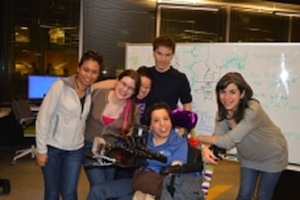MIT Hackathon Tackles Technologies To Benefit the Disabled
 One day at the end of Last month, a group of students
from the
Massachusetts Institute of Technology created a Bluetooth-powered mouse
that a
woman with cerebral palsy could direct by sipping and puffing with her
lips. Another
group developed a head motion-activated system to turn pages of a
musical score
for a conductor, also with cerebral palsy, and still another group built
a
workout app that can help somebody with diabetes adjust their insulin
after exercise.
One day at the end of Last month, a group of students
from the
Massachusetts Institute of Technology created a Bluetooth-powered mouse
that a
woman with cerebral palsy could direct by sipping and puffing with her
lips. Another
group developed a head motion-activated system to turn pages of a
musical score
for a conductor, also with cerebral palsy, and still another group built
a
workout app that can help somebody with diabetes adjust their insulin
after exercise.
And that's just some of what the winners of the school's Assistive
Technologies Hackathon (ATHack) accomplished. Fourteen other teams
with a total
of 70 undergraduate and graduate MIT students participated in the
one-day
hackathon to develop technologies and devices that would directly assist
specific
individuals with disabilities.
The hackathon took place at the MIT
Lincoln Laboratory Beaver
Works in Cambridge, MA, a joint center
operated
by the MIT Lincoln Laboratory and MIT School of Engineering that
leverages
synergies between campus research and the laboratory's technology areas.
"It
challenged students to
apply their technical skills to develop tools that would make a real
difference
in the quality of people's lives," said MIT senior Jaya Narain, one of
the
students who organized the event.
The 17
teams started several
weeks before the day of the hackathon by meeting with the clients to
talk about
what they might be able to do to help them live more independently. The
clients
had a range of disabilities, everything from cerebral palsy and diabetes
to
paraplegia and hearing and vision impairments.
The day of
the hackathon, a
number of Lincoln Laboratory volunteers were on hand to make sure the
students
took advantage of everything that was available to them at the lab.
"I have
never seen the
facility so teeming with innovation," said Beaver Works Manager John
Vivilecchia. "Every inch of space was humming with activity."
A
six-member panel of judges,
made up of Lincoln Laboratory engineers and MIT graduate students,
evaluated
the projects based on usability, creativity and functionality.
Not every
team's project was
successful, but even those that weren't planned to continue to refine
their
prototypes.
The
winning project was the
one that allowed a woman with cerebral palsy to use her computer mouse
by
sipping and puffing and second place went to the page turner for the
conductor
with cerebral palsy.
"Disabled
community members
need to know that there is an ongoing commitment to solving the
challenges they
face," said Joseph Martini, director of assistive technology at the Perkins
School for the Blind and one of the judges. "ATHack and
similar events will
hopefully influence more students to pursue projects and careers
relating to
assistive technology development."
About the Author
Michael Hart is a Los Angeles-based freelance writer and the former executive editor of THE Journal.